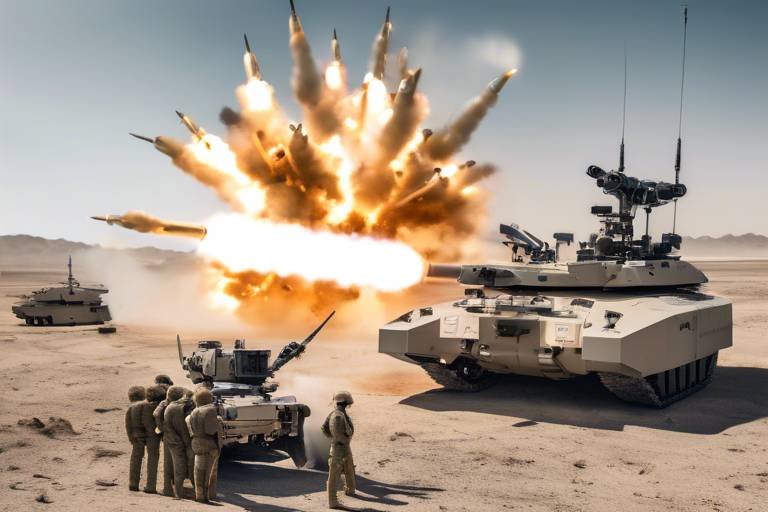Military Applications of AI in Biometric Security Systems
In an era where security is paramount, the integration of artificial intelligence (AI) within biometric security systems has emerged as a game-changer, particularly in military applications. These advanced systems not only enhance the ability to authenticate identities but also provide a robust framework for safeguarding sensitive information and personnel. Imagine a world where soldiers can seamlessly access secure areas without the cumbersome processes of traditional security checks. This is not just a dream—it's becoming a reality through the innovative use of AI in biometrics.
AI empowers biometric systems to operate with remarkable accuracy, speed, and reliability. Traditional methods of identity verification can be slow and prone to human error, leading to potential security breaches. However, with AI, these systems can analyze biometric data—such as fingerprints, facial features, and iris patterns—at lightning speed. This capability is crucial in military operations where time is often of the essence, and the stakes are incredibly high.
Moreover, the scalability of AI-driven biometric systems allows for the processing of vast amounts of data. This means that military organizations can manage and verify the identities of a large number of personnel quickly and efficiently. The potential for real-time analysis ensures that security measures can adapt swiftly to emerging threats, making it a vital tool in modern defense strategies.
As we delve deeper into the various applications of AI in biometric security, it becomes evident that this technology is not just about enhancing security protocols; it’s about revolutionizing the way military operations are conducted. From securing access to sensitive facilities to ensuring the integrity of personnel data, AI in biometrics is paving the way for a more secure and efficient future.
At its core, the integration of AI into biometric security systems represents a significant leap forward in identity verification processes. AI algorithms can learn from vast datasets, improving their performance over time and adapting to new challenges. This means that as threats evolve, so too do the systems designed to combat them. For military applications, this adaptability is crucial.
AI enhances biometric systems by:
- Improving accuracy: AI can reduce false positives and negatives, ensuring that only authorized personnel gain access.
- Speeding up verification: Quick processing of biometric data allows military operations to proceed without unnecessary delays.
- Increasing reliability: Continuous learning capabilities mean that AI can adjust to new biometric data, maintaining high security standards.
This convergence of AI and biometrics not only boosts security but also instills confidence among military personnel, knowing that their identities are protected by the latest technology.
Q1: What types of biometric technologies are used in the military?
A1: The military employs various biometric technologies, including fingerprint recognition, facial recognition, and iris scanning, each serving specific security needs.
Q2: How does AI improve the accuracy of biometric systems?
A2: AI algorithms analyze biometric data patterns more effectively than traditional methods, significantly reducing the chances of false identifications.
Q3: What are the main challenges in implementing AI-driven biometric systems?
A3: Challenges include privacy concerns, technological limitations, and resistance to change within military organizations.
Q4: Are there ethical concerns regarding the use of AI in military biometrics?
A4: Yes, ethical considerations include issues related to surveillance, consent, and the potential for misuse of biometric data.
Q5: How can AI-enhanced biometric systems integrate with other military security measures?
A5: These systems can work alongside other security protocols, creating a comprehensive approach to protecting personnel and sensitive information.

Overview of AI in Biometric Security
Artificial Intelligence (AI) has revolutionized the way biometric security systems operate, particularly in military contexts. Imagine a world where identity verification is not just a tedious task but a seamless process that enhances operational efficiency and security. That's precisely what AI brings to the table. By integrating advanced algorithms and machine learning techniques, biometric systems can now achieve unprecedented levels of accuracy, speed, and reliability. This transformation is crucial in military operations where the stakes are incredibly high.
At its core, AI enables biometric systems to learn from data, improving their performance over time. For instance, traditional biometric systems might struggle with variations in lighting or angles when scanning faces. However, AI algorithms can analyze vast datasets to recognize patterns and adapt to these changes, ensuring that identity verification remains robust under various conditions. This capability is essential for military personnel who operate in diverse environments, from urban settings to remote locations.
The integration of AI into biometric security also means that these systems can process enormous amounts of data in real-time. In a military scenario, this could involve scanning hundreds of faces or fingerprints in a matter of seconds, drastically reducing the time required for identity checks. Consider the implications: faster identification can lead to quicker decision-making, potentially saving lives during critical operations. Furthermore, AI can help in identifying potential threats more effectively by analyzing behavioral patterns and anomalies in data.
Moreover, AI-enhanced biometric systems can significantly reduce human error, a common issue in manual identity verification processes. By automating the recognition process, the likelihood of mistakes decreases, leading to a more secure environment. This is particularly vital in military operations, where every second counts, and the margin for error is razor-thin.
However, the journey of integrating AI into biometric security is not without its challenges. There are concerns regarding privacy and the ethical implications of surveillance, especially when it comes to monitoring personnel and civilians. As these systems become more prevalent, it is crucial to address these issues proactively to ensure that the benefits of AI in biometric security are realized without compromising individual rights.
In summary, the integration of AI into biometric security systems within the military context is a game-changer. It enhances the accuracy and speed of identity verification while reducing human error and processing vast amounts of data efficiently. As we move forward, the potential for AI to transform military operations is immense, but it must be handled with care to navigate the ethical landscape that accompanies such advancements.
- What is biometric security? Biometric security refers to systems that use unique physical characteristics, such as fingerprints, facial recognition, or iris scans, to verify an individual's identity.
- How does AI improve biometric security? AI enhances biometric security by increasing accuracy, speed, and reliability, allowing systems to learn from data and adapt to various conditions.
- Are there privacy concerns with AI in biometric systems? Yes, there are significant privacy concerns related to surveillance and the ethical implications of monitoring individuals, which need to be addressed as these technologies are implemented.
- Can AI biometric systems work in real-time? Absolutely! AI can process vast amounts of data in real-time, making it possible to identify individuals quickly during military operations.

Types of Biometric Technologies
In the realm of military applications, biometric technologies serve as a cornerstone for enhancing security and streamlining identity verification processes. These technologies leverage unique physiological and behavioral characteristics to authenticate individuals, making them invaluable in military contexts where security is paramount. Let’s delve into some of the most prominent types of biometric technologies that are shaping the future of military security.
One of the most widely recognized biometric methods is fingerprint recognition. This technology analyzes the unique patterns of ridges and valleys on an individual's fingertips. It’s not just about matching prints; advanced algorithms can process fingerprints quickly, making it possible to verify identities within seconds. In military operations, where time is often of the essence, this speed can be a game-changer. For instance, fingerprint scanners can be deployed at checkpoints to ensure that only authorized personnel gain access to secure areas.
Another significant technology is facial recognition. This system utilizes algorithms to detect and analyze facial features, creating a digital map of a person's face. With the integration of artificial intelligence, these systems can learn and adapt, improving their accuracy over time. In military settings, facial recognition is particularly useful for identifying individuals in crowds or monitoring entry points to secure facilities. The ability to quickly identify threats or unauthorized personnel can drastically enhance operational security.
Iris scanning is yet another advanced biometric technology that is gaining traction in military applications. The iris, the colored part of the eye, contains unique patterns that are incredibly difficult to replicate. Iris scanners capture high-resolution images of the iris and use sophisticated algorithms to verify identity. This method is especially useful in scenarios where high security is required, such as accessing classified information or entering secure installations. The accuracy of iris scanning makes it a reliable choice for military operations.
Beyond these traditional methods, there are also behavioral biometrics, which analyze patterns in how individuals interact with devices. This can include keystroke dynamics, mouse movements, and even gait analysis. While still emerging in military applications, the potential for behavioral biometrics to provide continuous authentication is promising. Imagine a soldier’s device that recognizes their unique typing style or how they hold their weapon, ensuring that only they can access sensitive information or equipment.
To summarize, the military is harnessing a variety of biometric technologies, each with its unique strengths and applications:
| Biometric Technology | Description | Military Application |
|---|---|---|
| Fingerprint Recognition | Analyzes unique patterns on fingertips | Access control at checkpoints |
| Facial Recognition | Detects and analyzes facial features | Identifying individuals in secure areas |
| Iris Scanning | Captures unique patterns in the iris | Access to classified information |
| Behavioral Biometrics | Analyzes patterns in user behavior | Continuous authentication of personnel |
As we can see, the integration of these technologies not only enhances security but also streamlines operations within military contexts. The future of military security is undoubtedly intertwined with advancements in biometric technologies, paving the way for more secure and efficient operations.
- What is biometric technology? Biometric technology uses unique physical or behavioral characteristics for identity verification.
- How does facial recognition work? It analyzes facial features and creates a digital map to identify individuals.
- Are biometric systems secure? Yes, they provide a high level of security by relying on unique personal traits.
- What are the challenges of using biometric technology in the military? Challenges include privacy concerns, technological limitations, and the potential for misuse.

Benefits of AI-Enhanced Biometrics
The integration of artificial intelligence (AI) into biometric systems has revolutionized security protocols, especially within military contexts. Imagine a world where identity verification is not only fast but also incredibly accurate. This is precisely what AI-enhanced biometrics offers. One of the most significant benefits is the **increased security** it provides. Traditional security measures often rely on passwords or physical tokens, which can be lost, stolen, or easily compromised. In contrast, biometric systems utilize unique physical characteristics—like fingerprints, facial features, or iris patterns—making it exceedingly difficult for unauthorized individuals to gain access.
Moreover, AI enhances the **speed and efficiency** of these biometric systems. With advanced algorithms, AI can process biometric data in real-time, allowing military personnel to verify identities almost instantaneously. This capability is crucial in high-stakes environments where every second counts. For instance, consider a scenario where a soldier needs to identify a potentially hostile individual in a crowded area. AI-driven biometric systems can quickly analyze facial recognition data against a database of known threats, enabling swift decision-making that could save lives.
Another notable advantage is the **reduction of human error**. Human operators can make mistakes, whether due to fatigue, stress, or simple oversight. AI systems, however, are designed to minimize these errors by relying on data-driven decision-making. This means that the likelihood of misidentifying an individual is significantly lower, which is paramount when dealing with sensitive military operations. To illustrate, AI algorithms can achieve accuracy rates exceeding 99% in certain biometric applications, far surpassing human capabilities.
Additionally, AI-enhanced biometric systems can handle **vast amounts of data** efficiently. In military operations, the ability to process and analyze large datasets—such as surveillance footage or personnel records—can lead to better insights and enhanced security measures. For example, by analyzing patterns in biometric data, AI can identify potential threats before they materialize, allowing for proactive security measures rather than reactive ones.
Furthermore, the implementation of AI in biometric systems leads to **cost savings** in the long run. While the initial investment may be significant, the reduction in security breaches, theft, and unauthorized access can lead to substantial financial savings. Organizations can allocate resources more effectively, focusing on strategic initiatives rather than constantly addressing security failures.
However, it’s essential to acknowledge that these benefits come with their own set of challenges, which we will explore in the following sections. But for now, it’s clear that AI-enhanced biometrics represent a significant leap forward in military security technology, offering a blend of accuracy, efficiency, and reliability that is hard to ignore.
- What are biometric systems? Biometric systems use unique physical traits, such as fingerprints or facial recognition, to verify identity.
- How does AI improve biometric security? AI enhances speed, accuracy, and reduces human error in biometric verification processes.
- Are there privacy concerns with AI-enhanced biometrics? Yes, the use of biometric data raises ethical issues regarding surveillance and consent.
- Can AI-driven biometric systems be hacked? While they are more secure than traditional methods, no system is entirely immune to hacking.
- What is the future of AI in military biometrics? The future will likely see more advanced AI algorithms, increased integration with other security systems, and ongoing improvements in accuracy and efficiency.

Challenges in Implementation
Implementing AI-driven biometric security systems in the military is not without its hurdles. While the technology promises enhanced security and efficiency, several challenges can impede its successful integration. One of the most significant issues is privacy concerns. As biometric systems often require the collection and storage of sensitive personal data, there is a fine line between ensuring security and infringing on individual privacy rights. Military personnel and their families might feel uncomfortable with the idea of their biometric data being constantly monitored and stored, raising questions about consent and data ownership.
Another considerable challenge is technological limitations. While AI and biometric technologies have advanced significantly, they are not infallible. For instance, biometric systems can sometimes struggle with accuracy in diverse environments or under varying conditions. Factors like lighting, weather, or even the physical state of an individual (such as injuries or changes in appearance) can affect the reliability of these systems. This variability can lead to false positives or negatives, which can have serious implications in military operations where every second counts.
Moreover, there is often a resistance to change within military organizations. The military is traditionally known for its adherence to established protocols and systems. Introducing new technologies can be met with skepticism, particularly from personnel who are accustomed to existing methods. Training staff to use AI-enhanced biometric systems effectively requires time, resources, and a shift in mindset, which can be daunting. This resistance can slow down the adoption of innovative solutions that could significantly enhance operational security.
Additionally, the integration of AI in biometric systems raises concerns about cybersecurity. With the increasing sophistication of cyber threats, the risk of hacking or data breaches is a constant worry. If biometric systems are compromised, the implications could be dire, not just for individual privacy but also for national security. Ensuring that these systems are fortified against such threats is critical, yet it requires ongoing investment and vigilance.
Finally, there is the challenge of cost. Implementing AI-driven biometric systems involves substantial financial investment in both technology and training. Military budgets can be tight, and allocating funds towards new technologies might compete with other pressing needs. Decision-makers must weigh the costs against the potential benefits, which can often lead to difficult choices.
In summary, while the potential for AI-enhanced biometric security systems in the military is vast, these challenges must be carefully navigated. Addressing privacy concerns, overcoming technological limitations, managing resistance to change, enhancing cybersecurity measures, and balancing costs are all critical to ensuring successful implementation. By tackling these issues head-on, the military can harness the power of AI and biometrics to create a safer and more secure environment for its personnel and operations.
- What are the main privacy concerns associated with biometric security systems?
Privacy concerns primarily revolve around the collection, storage, and potential misuse of sensitive personal data. Military personnel may worry about how their biometric data is used and who has access to it. - How do technological limitations affect the accuracy of biometric systems?
Technological limitations can lead to inaccuracies in biometric recognition due to environmental factors such as lighting and weather, or physical changes in individuals, which can result in false positives or negatives. - Why is there resistance to adopting AI-driven biometric systems in the military?
Resistance often stems from a preference for established protocols and skepticism about new technologies. Training and transitioning to new systems can also be seen as time-consuming and resource-intensive. - What cybersecurity risks are associated with biometric systems?
Biometric systems can be vulnerable to hacking and data breaches, leading to severe implications for privacy and national security if sensitive biometric data is compromised. - What are the costs involved in implementing AI-enhanced biometric systems?
Costs include purchasing technology, ongoing maintenance, and training personnel, which can be significant and may compete with other military budget priorities.

Case Studies of AI in Military Biometric Security
In recent years, the integration of artificial intelligence (AI) into military biometric security systems has dramatically transformed how armed forces operate. A few compelling case studies highlight the effectiveness of this technology in enhancing security measures and ensuring the safety of personnel and sensitive information.
One notable example is the implementation of AI-driven facial recognition systems by the U.S. Department of Defense. This system was deployed in various military bases to monitor access points and track individuals entering and exiting secure areas. By utilizing advanced algorithms, the system can analyze facial features with incredible speed and accuracy, significantly reducing the risk of unauthorized access. The results have been promising, with reports indicating a 30% decrease in security breaches since the system's introduction.
Another remarkable case can be found in the British Army, which has been experimenting with iris scanning technology for personnel identification. In a pilot program, soldiers were equipped with portable iris scanners that could quickly verify identities in the field. This technology not only enhanced security but also streamlined operations, allowing troops to focus on their primary missions without the delays typically associated with manual identification methods. The feedback from personnel has been overwhelmingly positive, showcasing a newfound confidence in the security measures in place.
Moreover, the Israeli Defense Forces (IDF) have taken a step further by integrating AI biometrics with existing surveillance systems. They developed a comprehensive security network that combines fingerprint recognition, facial recognition, and behavioral analysis to create a multi-layered defense mechanism. This system analyzes real-time data from various sources, including drones and ground sensors, to identify potential threats before they materialize. The IDF reported that this approach has led to a significant increase in threat detection rates, enhancing operational readiness and response times.
These case studies not only illustrate the successful application of AI in military biometric security but also highlight the transformative potential of such technologies. However, it’s essential to acknowledge the challenges faced during these implementations. For instance, while these systems improve security, they also raise questions about privacy and the ethical implications of constant surveillance. Military organizations must balance the need for security with respect for individual rights, ensuring that the deployment of such technologies does not infringe upon personal freedoms.
In conclusion, as military forces continue to adopt AI-enhanced biometric systems, the lessons learned from these case studies will serve as a foundation for future innovations. The effectiveness of these technologies in enhancing security measures is clear, but ongoing dialogue about ethical considerations and privacy will be crucial as we navigate this rapidly evolving landscape.
- What are the main benefits of using AI in military biometric security?
AI enhances accuracy, speed, and reliability in identity verification, reducing human error and improving overall security. - What types of biometric technologies are commonly used in the military?
Common technologies include fingerprint recognition, facial recognition, and iris scanning, each serving specific security needs. - What challenges do military organizations face when implementing AI-driven biometric systems?
Challenges include privacy concerns, technological limitations, and resistance to change within organizations. - How can AI and biometric systems be integrated with other security measures?
Integration can create a comprehensive approach to safeguarding personnel and sensitive information across various platforms.

Future Trends in Biometric Security
As we look ahead, the landscape of biometric security is poised for significant transformation, driven largely by advancements in artificial intelligence. The integration of AI into biometric systems not only enhances their capabilities but also opens the door to innovative applications that were previously unimaginable. One of the most exciting trends is the development of multimodal biometric systems, which combine various biometric identifiers—like fingerprints, facial recognition, and iris scans—into a single, cohesive security solution. This approach not only increases the accuracy of identity verification but also significantly reduces the chances of false positives and negatives.
Moreover, the rise of deep learning algorithms is revolutionizing how biometric data is processed. These algorithms can analyze vast datasets to identify patterns and anomalies, thereby improving the speed and reliability of biometric recognition systems. Imagine a scenario where a military base can instantly verify the identity of personnel, even in challenging environments, thanks to AI's ability to learn and adapt in real-time. This capability is not just a futuristic dream; it's rapidly becoming a reality.
Another trend to watch is the increasing emphasis on privacy-preserving technologies. As biometric data becomes more prevalent, concerns regarding data security and individual privacy are rising. Innovations such as federated learning allow AI models to be trained on decentralized data sources without compromising sensitive information. This means that military organizations can enhance their security protocols while still respecting the privacy of personnel. The balance between effective security and privacy will be a key focus in the coming years.
Additionally, the integration of biometric systems with blockchain technology is gaining traction. By utilizing blockchain’s decentralized and immutable ledger capabilities, military applications can ensure that biometric data is stored securely and is tamper-proof. This combination not only enhances security but also provides a transparent audit trail, which is crucial for compliance and accountability in military operations.
In terms of user experience, we can expect biometric systems to become increasingly user-friendly. Advances in user interface design and the incorporation of natural language processing will allow personnel to interact with these systems more intuitively. Imagine a scenario where a soldier can simply speak their command to access secure areas or systems, making the process seamless and efficient.
Finally, as military operations become more globalized, the need for interoperability among different biometric systems across various branches and allied forces will be paramount. Future trends will likely focus on developing standardized protocols that allow for seamless data sharing and communication between different biometric systems, enhancing collaboration and operational effectiveness on a multinational scale.
- What are multimodal biometric systems? These systems utilize multiple biometric identifiers to improve accuracy and reduce errors in identity verification.
- How does AI enhance biometric security? AI improves biometric systems by analyzing large datasets, identifying patterns, and adapting to new data in real-time, which increases speed and reliability.
- What are privacy-preserving technologies? These are innovations that allow for the training of AI models on sensitive data without compromising individual privacy, such as federated learning.
- How can blockchain technology be integrated with biometric systems? Blockchain can provide a secure, tamper-proof storage solution for biometric data, ensuring its integrity and enhancing accountability.
- What is the future of user experience in biometric systems? Expect advancements that make these systems more intuitive, including voice commands and user-friendly interfaces.
- Why is interoperability important in military biometric systems? Interoperability allows for seamless communication and data sharing between different military branches and allied forces, enhancing collaboration and operational effectiveness.

Ethical Considerations
When we delve into the realm of artificial intelligence and its integration into biometric security systems, particularly within military contexts, it's crucial to pause and reflect on the that arise. The use of AI in biometrics is not merely a technological advancement; it raises profound questions about privacy, consent, and the potential for misuse. As we harness these powerful tools to enhance security, we must also navigate the murky waters of ethics with care.
One of the primary concerns is the issue of surveillance. In military applications, the ability to monitor personnel and identify individuals through biometric data can lead to an intrusive environment. Imagine a scenario where every move is tracked, and every interaction is analyzed. While this can enhance security, it also risks creating a culture of distrust. How do we balance the need for security with the fundamental right to privacy? This question becomes even more complex in a military setting, where operational security is paramount, but so is the well-being of the personnel involved.
Another significant ethical dilemma revolves around consent. In many cases, individuals may not fully understand what it means to have their biometric data collected and used. For military personnel, the lines of consent can blur, especially when the stakes are high. Are they truly giving informed consent, or are they simply complying with directives? This ambiguity can lead to ethical breaches that undermine trust and morale within the ranks.
Moreover, the potential for misuse of biometric data cannot be overlooked. With great power comes great responsibility, and the military's access to advanced biometric technologies poses risks if not handled appropriately. There is a real danger that such technologies could be weaponized, used against individuals for purposes beyond security, or even exploited for personal gain. The military must establish robust frameworks to ensure that these technologies are used ethically and responsibly.
To navigate these ethical waters, it is essential for military leaders and policymakers to engage in ongoing dialogues about the implications of AI in biometric security. This dialogue should include input from a diverse range of stakeholders, including ethicists, technologists, and the personnel who will be affected by these systems. Additionally, implementing strict guidelines and oversight mechanisms can help mitigate ethical risks. For instance, establishing clear protocols for data handling, ensuring transparency in how biometric data is used, and fostering an environment where personnel feel safe to voice their concerns can go a long way in addressing these issues.
In conclusion, while the integration of AI in biometric security systems offers remarkable potential for enhancing military operations, it is imperative to approach these advancements with a keen awareness of the ethical considerations involved. By prioritizing ethics alongside technology, the military can create a more secure and respectful environment for all personnel.
- What are the main ethical concerns regarding AI in military biometrics?
The primary concerns include privacy, consent, and potential misuse of biometric data. - How can the military ensure ethical use of biometric technologies?
By establishing clear guidelines, ensuring transparency, and fostering open dialogue among stakeholders. - What role does consent play in the use of biometric systems?
Consent is crucial, as individuals must understand how their biometric data is collected and used, especially in a military context. - Can AI in biometrics lead to a culture of surveillance?
Yes, while enhancing security, it can also create an environment of distrust if not managed carefully.

Integration with Other Security Systems
In today's rapidly evolving military landscape, the integration of AI-enhanced biometric systems with other security measures is not just a benefit; it's a necessity. Imagine a fortress where every wall is fortified and every entry point is monitored—this is the level of security that modern military operations strive to achieve. By combining biometric technologies such as facial recognition and fingerprint scanning with traditional security systems, military forces can create a comprehensive approach that significantly enhances their operational security.
One of the most significant advantages of this integration is the ability to create a multi-layered security environment. For instance, when biometric systems are paired with surveillance cameras, real-time data can be analyzed to identify potential threats swiftly. This synergy allows security personnel to not only verify identities but also to assess behaviors and movements, leading to quicker decision-making processes. Furthermore, integrating biometric systems with access control technologies ensures that only authorized personnel can access sensitive areas, dramatically reducing the risk of insider threats.
Consider the following table that illustrates how different security systems can work together:
| Security System | Function | Integration Benefits |
|---|---|---|
| Facial Recognition | Identifies individuals based on facial features | Quick identification and tracking of personnel in real-time |
| Fingerprint Scanning | Verifies identity through unique fingerprint patterns | High accuracy in access control, reducing false positives |
| Surveillance Cameras | Monitors environments for suspicious activities | Enhanced situational awareness and threat detection |
| Access Control Systems | Regulates entry to secure areas | Prevents unauthorized access, ensuring safety of sensitive information |
Moreover, the integration of AI-driven biometric systems with data analytics platforms opens new avenues for predictive security measures. By analyzing patterns and behaviors, military organizations can anticipate potential threats before they materialize. This proactive approach is akin to having a crystal ball that reveals future dangers, allowing military personnel to act rather than react.
However, this integration is not without its challenges. Technical compatibility between different systems can pose significant hurdles. Military organizations must ensure that all systems can communicate effectively and securely. Additionally, there are concerns about data privacy and the ethical implications of using such advanced technologies in surveillance. Striking the right balance between security and individual rights is crucial, and ongoing dialogue about these issues is necessary to foster trust among military personnel and the public.
In conclusion, the integration of AI-enhanced biometric systems with other security measures is a game-changer for military operations. It creates a robust security framework that not only protects sensitive information and personnel but also enhances overall situational awareness. As technology continues to advance, the potential for even more sophisticated integrations will only grow, paving the way for a future where military security is as seamless as it is effective.
- What are biometric systems? Biometric systems use unique physical characteristics, such as fingerprints or facial features, to verify an individual's identity.
- How does AI enhance biometric security? AI improves biometric security by increasing accuracy, speed, and the ability to analyze vast amounts of data quickly.
- What are the challenges of integrating biometric systems? Challenges include technical compatibility, privacy concerns, and the need for consistent training among personnel.
- Can biometric systems be hacked? While biometric systems are generally secure, no system is entirely immune to hacking, which is why continuous updates and security measures are essential.
Frequently Asked Questions
- What is the role of AI in biometric security systems?
AI plays a crucial role in enhancing biometric security systems by improving the accuracy and speed of identity verification processes. It allows for the analysis of vast amounts of data quickly, making it easier to identify individuals accurately, which is essential in military operations where security is paramount.
- What are the most common types of biometric technologies used in the military?
In the military, the most common biometric technologies include fingerprint recognition, facial recognition, and iris scanning. Each of these technologies has its specific applications, such as access control, surveillance, and identification of personnel in sensitive areas.
- What benefits do AI-enhanced biometric systems provide?
AI-enhanced biometric systems offer several benefits, including increased security through more reliable identity verification, reduced human error, and the ability to process large datasets efficiently. This leads to faster decision-making and improved operational security.
- What challenges are faced when implementing AI in military biometric systems?
Implementing AI in military biometric systems comes with challenges such as privacy concerns, potential technological limitations, and resistance to change within military organizations. Addressing these challenges is critical for successful integration and acceptance of the technology.
- Can you provide examples of AI in military biometric security?
Yes! There are several real-world examples where AI has been successfully implemented in military biometric security. These case studies highlight the effectiveness of AI in enhancing security measures, such as in border control or access management at military bases.
- What future trends can we expect in biometric security?
The future of biometric security will likely see advancements in AI technologies, making systems even more accurate and efficient. Innovations may include improved algorithms for facial recognition and the integration of biometric data with other security systems for comprehensive protection.
- What ethical considerations are there regarding AI in biometric security?
There are several ethical implications surrounding the use of AI in biometric security, including concerns about surveillance, consent, and the potential misuse of technology. It’s essential to address these issues to ensure that the use of such technologies is responsible and respects individual rights.
- How can AI-enhanced biometric systems integrate with other security measures?
AI-enhanced biometric systems can be integrated with other military security measures, such as access control systems and surveillance technologies. This comprehensive approach ensures that personnel and sensitive information are safeguarded across various platforms, enhancing overall security.



















